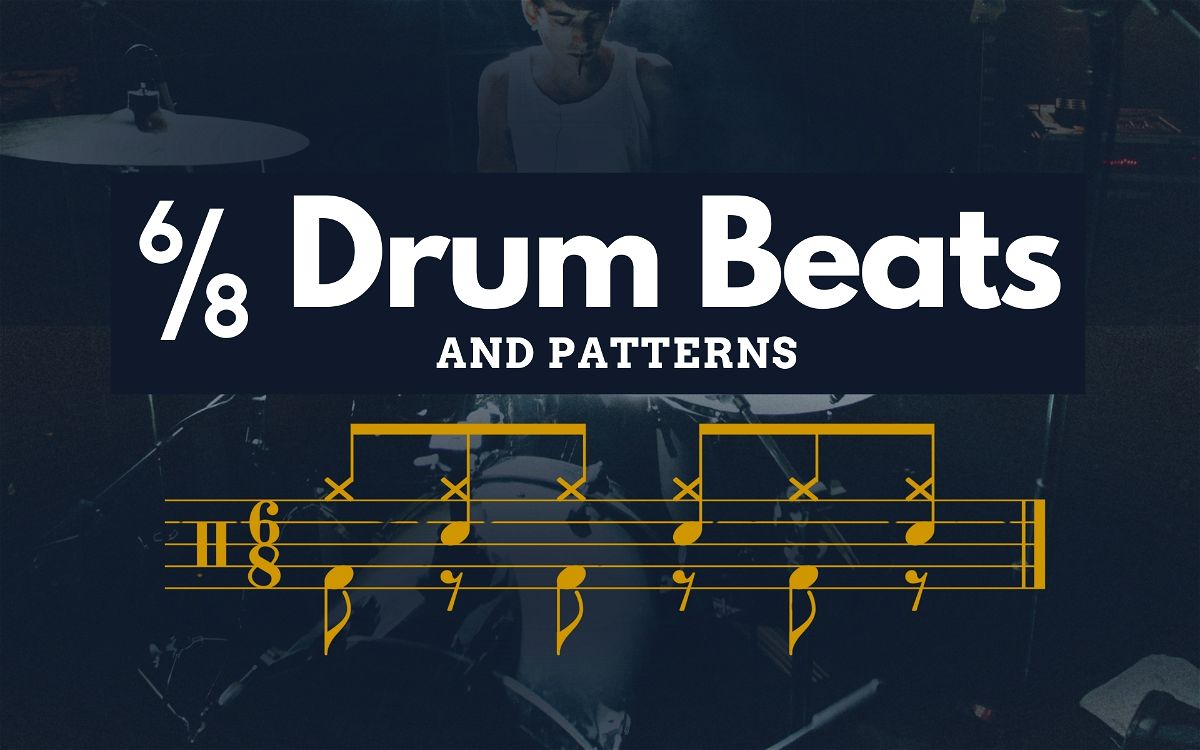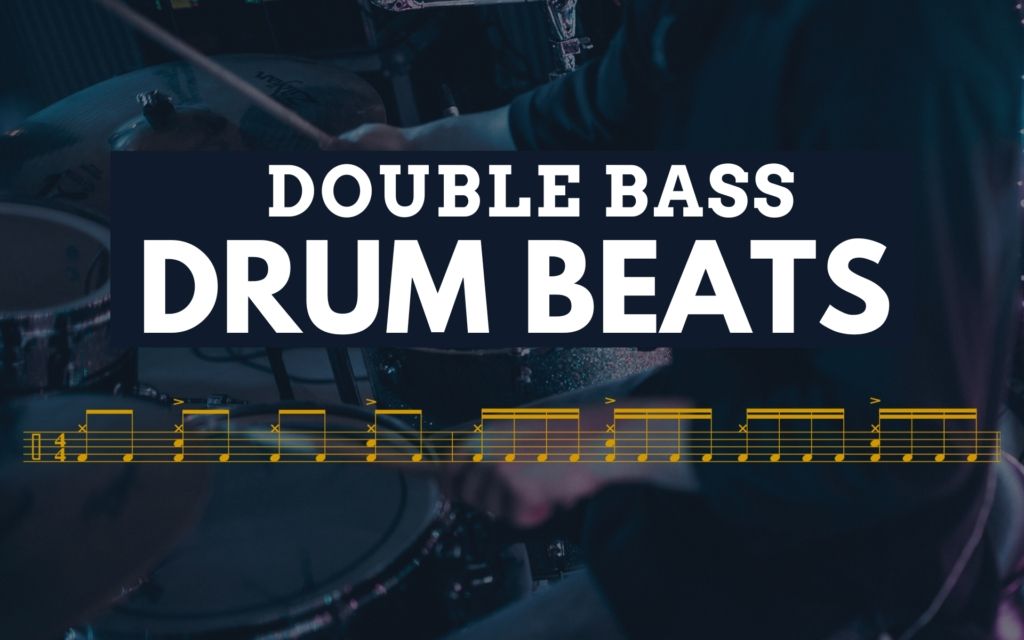6/8 is a surprisingly complicated time signature to play on the drums. While there are plenty of songs with it, it’s always hard for drummers to get the hang of at first.
The notes themselves may be easy to play and count, but getting the feel right typically takes some time.
If you’re looking to learn a few good 6/8 drum grooves, you’ve come to the right place. I’ve compiled a list of 12 of them that are commonly used in various songs.
I’ve also included an audio file with each groove so that you can have an audible reference.
Contents
How to Count 6/8 Time
Before we get started with the grooves, it’s important to understand how to count 6/8 time, as it’s a bit different from your standard 4/4 time signature.
With a 4/4 groove, you count “1 2 3 4” for quarter notes. If it has eighth notes, you count “1 + 2 + 3 + 4 +.” If it has 16thnotes, you count “1e+a 2e+a 3e+a 4e+a”.
You have to throw that counting system out the window with 6/8 time, as the note values work a bit differently within a bar.
For a standard 6/8 bar, you count all the 8th notes as “1 2 3 4 5 6.” If the bar has 16th notes, then you count them as “1 and 2 and 3 and 4 and 5 and 6 and.”
Now that we have that out of the way, let’s get to the grooves!
Groove 1

The first drum beat we’re going to play is like a basic rock beat, but it comes in the form of a 6/8 groove. You’re going to play the hi-hat on all of the 8th note counts.
You’ll then play the bass drum on count 1 and the snare drum on count 4. This gives you a really basic rhythm that allows you to feel out the 6/8 time.
There’s one thing you can do to make the groove sound more musical. You can accent the hi-hat notes on beat 1 and 4. Then play the hi-hat a bit softer on all of the other counts.
This is essentially a basic rock groove with three hi-hat notes between every snare and kick instead of two.
Groove 2

Moving onto the next groove, you’re going to keep the same base that we worked on in the last drum beat. You’re then going to add another bass drum stroke on count 3 of the bar. That bass drum will fall just before the snare drum, giving you a swaying feel.
There are two ways that you can play this. Firstly, you can play both bass drum notes with the same velocity, giving you a solid and heavy groove.
The next option is to play the second bass drum note a bit lighter. This creates an effect where it sounds like the groove falls into the snare drum stroke, which is pretty cool!
Groove 3

We’re going to continue adding onto what we’ve learned by simply putting in another stroke. So, you’re going to keep the pattern from groove 2, but you’re going to play an extra snare drum note at the end of the bar on count 6.
However, that snare drum note is going to be a ghost note, meaning you’re going to play it a lot softer than a typical note.
The first half of the groove has two bass drum notes, while the second half of the groove has two snare drum notes.
Groove 4

We’re going to change things up a bit for this next groove by playing two kick drums in a row. Those two kick drums will come on count 1 and 2 of the bar. You’ll then play a snare drum on count 4, along with a hi-hat on all 6 counts.
Depending on how fast you play this beat, it can actually be very tricky to perform cleanly. I’ve often found that playing quick consecutive bass drums in 6/8 grooves causes me to lose my balance. It’s something that I had to practice for quite a bit to feel more comfortable when doing.
Groove 5

In this groove, you’re going to add in a quick ghost note before playing two kick drum notes. That string of notes will lead into a really loud rimshot for the backbeat.
The second half of the bar will have two more ghost notes in between the hi-hats to end the groove. This starts sounding really cool when you speed it up and play the groove over and over.
Groove 6

You’re going to start this groove by playing a kick drum on count 1. You’ll then play a snare drum on count 2, followed by another kick drum on count 3.
After that, you’ll play a snare drum on count 4, and then end the bar by playing two hi-hats on counts 5 and 6.
So, you’re basically alternating between your snare drum and kick drum on every 8th note count at the beginning of the bar. You’re then leaving space near the end before doing it again when you repeat the groove.
Groove 7

Now we’re going to bring 16th notes into the mix. Remember that a 16th note will be counted as an “and” in a 6/8 groove.
For this first one, you’re going to start by playing a bass drum on count 1. You’ll follow that with a quick snare drum on the “and” of count 1, which will then lead to another kick drum on count 2.
The rest of the groove just has hi-hats with a snare drum on count 4.
Groove 8

Here’s another Afro-Cuban groove that has a lot more drive to it. You’ll regularly hear this kind of beat being played in jazz, as it sounds great when you switch from this to a jazz swing.
A lot of jazz is also Afro-Cuban-inspired, so beats like this just fit so well.
The main thing that anchors the groove is the consistent bass drum pulse. You’re then going to play around between your hi-hat and snare drum to create different rhythmic patterns.
Groove 9

This is one of my favorite grooves on this list. You’re simply going to constantly alternate between playing your bass drum and snare drum throughout the whole bar.
The more you play it, the more it starts to sound like a standard 4/4 groove. This can get confusing, but it can also be a cool groove illusion.
The best way not to get tripped up, though, is to make the snare drum on count 4 really loud. That will solidify the 6/8 feel.
Groove 10

Things are about to get a lot heavier with this metal groove. You’ll need a double pedal to play this, as you’re going to play a consistent string of bass drum notes in the first part of the groove.
You’ll also double the notes up at the end of the bar to create a fill-in with your bass drum to restart the groove.
Groove 11

Our last groove moves more toward the quieter side of things. We’re going to go from playing a big metal groove to playing a subtle jazz swing groove.
Jazz can often feel really weird to play in 6/8, so it’s good to start with grooves like this to get used to the overall feel.
Remember to play the pattern on your ride cymbal, and then make sure that your bass drum and snare drum strokes are ver subtle.
Conclusion
I highly recommend using a metronome when practicing these grooves, as it can take a while to get used to the 6/8 feel. Just make sure to set the metronome to 6/8 time, as it will naturally count 4/4 time when you first start it up.
Once you have them down, try to find some fun 6/8 songs to play. You can then try all of these grooves out to see if they fit the tunes. Your best bet is blues music, but there are plenty of other styles as well that have 6/8 grooves, including jazz music and pop music.
Here are some good popular music song options to check out:
- We Are The Champions – Queen
- Call Me – Blondie
- Lights – Journey
- Toxicity – System of a Down
- Breakaway – Kelly Clarkson
- Iris – Goo Goo Dolls
- From the Inside – Linkin Park
Whether you’re a beginner drummer or not, remember to take things slow, work on your muscle memory, and then dial in your technique while tackling each groove. 6/8 grooves should feel just as comfortable as 4/4 grooves once you get them going!









